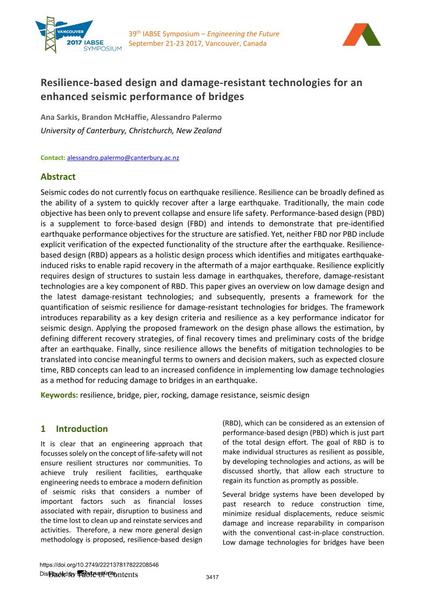Resilience-based design and damage-resistant technologies for an enhanced seismic performance of bridges

|
|
|||||||||||
Bibliografische Angaben
| Autor(en): |
Ana Sarkis
(University of Canterbury, Christchurch, New Zealand)
Brandon McHaffie (University of Canterbury, Christchurch, New Zealand) Alessandro Palermo (University of Canterbury, Christchurch, New Zealand) |
||||
|---|---|---|---|---|---|
| Medium: | Tagungsbeitrag | ||||
| Sprache(n): | Englisch | ||||
| Tagung: | IABSE Symposium: Engineering the Future, Vancouver, Canada, 21-23 September 2017 | ||||
| Veröffentlicht in: | IABSE Symposium Vancouver 2017 | ||||
|
|||||
| Seite(n): | 3417-3424 | ||||
| Anzahl der Seiten (im PDF): | 8 | ||||
| Jahr: | 2017 | ||||
| DOI: | 10.2749/222137817822208546 | ||||
| Abstrakt: |
Seismic codes do not currently focus on earthquake resilience. Resilience can be broadly defined as the ability of a system to quickly recover after a large earthquake. Traditionally, the main code objective has been only to prevent collapse and ensure life safety. Performance-based design (PBD) is a supplement to force-based design (FBD) and intends to demonstrate that pre-identified earthquake performance objectives for the structure are satisfied. Yet, neither FBD nor PBD include explicit verification of the expected functionality of the structure after the earthquake. Resilience- based design (RBD) appears as a holistic design process which identifies and mitigates earthquake- induced risks to enable rapid recovery in the aftermath of a major earthquake. Resilience explicitly requires design of structures to sustain less damage in earthquakes, therefore, damage-resistant technologies are a key component of RBD. This paper gives an overview on low damage design and the latest damage-resistant technologies; and subsequently, presents a framework for the quantification of seismic resilience for damage-resistant technologies for bridges. The framework introduces reparability as a key design criteria and resilience as a key performance indicator for seismic design. Applying the proposed framework on the design phase allows the estimation, by defining different recovery strategies, of final recovery times and preliminary costs of the bridge after an earthquake. Finally, since resilience allows the benefits of mitigation technologies to be translated into concise meaningful terms to owners and decision makers, such as expected closure time, RBD concepts can lead to an increased confidence in implementing low damage technologies as a method for reducing damage to bridges in an earthquake. |
||||
| Stichwörter: |
Brücke Erdbebenbemessung Pfeiler
|
||||
